Translate this page into:
The evolution of Irish Medical Journals
[To cite: Pandya SK. The evolution of Irish Medical Journals. Natl Med J India 2024;37:346–51. DOI: 10.25259/NMJI_436_2024]
We are indebted to Dr Thomas Percy Claude Kirkpatrick (1869–1954)1,2 for much valuable information on this subject. He was famed not only as a physician but also as a historian, author and a witty speaker. His papers, manuscripts and other invaluable documents (such as the fee book of Dr Abraham Colles) have been preserved at the Royal College of Physicians of Ireland.
THE DUBLIN MEDICAL AND PHYSICAL ESSAYS QUARTERLY
Six volumes were published in 1807–1808 but I have not been able to trace any of them. Some details on this journal can be learnt from Fleetwood’s The History of Medicine in Ireland.3 Of the four founders—Hugh Ferguson, Francis Barker, Samuel Bell Labatt and Charles Hawkes Todd—three had studied in Edinburgh. As a matter of policy, they decided to accept only those papers that were signed by their authors and reject papers dealing with medical reforms. The first volume contained a description of an improved method of lithotomy. Papers were not limited to human medical matters. Sir Philip Crampton described a new muscle in the orbits of birds. It is noteworthy that this paper was later presented at the Royal Society of London by Sir Humphrey Davy.
Six issues were published in all, the last in June 1808. No medical journal was published in Dublin till 1817 though Fleetwood does refer to The Dublin Hospital Reports (published in 1817, 1818, 1822, 1827 and 1830); The Dublin Hospital Gazette (1845–46) and the Irish Hospital Gazette (1873–75).
THE TRANSACTIONS OF THE ASSOCIATION OF THE FELLOWS AND LICENTIATES OF THE KING’S AND QUEEN’S COLLEGE OF PHYSICIANS1
The Association of Fellows and Licentiates owed its existence to its first President, Dr William Brooke. Meetings were held at his home, and he kept the minutes. He was the intermediary between the Association and the College of Physicians. He was nominated the first President of the Association. He was reelected to that office at the first annual meeting in May 1817 and in November 1827. It was probably he who supervised the issue of the Transactions till his death in 1829.
Dr William Brooke was born in 1769. He studied medicine in Edinburgh and obtained his MD there in June 1789. In 1793 he was admitted as Licentiate of the King’s and Queen’s College of Physicians. In the summer of 1824 the University of Dublin granted him the degree of MD. He was elected a Fellow of the College of Physicians in the same year. In 1826 he was elected President. He lectured in Medicine at the Jervis Street Hospital School. He died on 28 June 1829.
Five volumes of Transactions were published between 1817 and 1828 (Fig. 1). After his death a new series was started, of which, however, only one volume was published in 1830. The Association had 45 members on its roll during the Session of 1827–28. Paucity of funds may have been the reason for discontinuing the Transactions. On 1 March 1832, the Dublin Journal of Medical and Chemical Science appeared. The Association appears to have seized this opportunity for routing their papers to that journal.
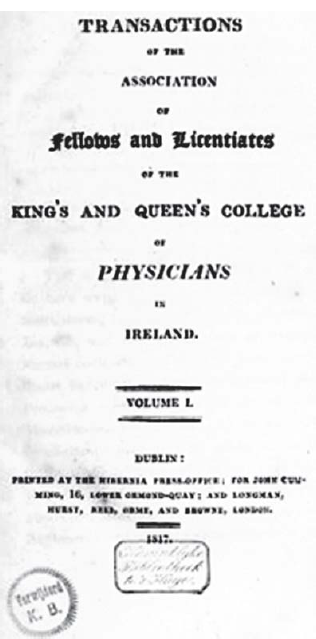
- Title page of the Transactions of the Association of Fellows and Licentiates of the King’s and Queen’s College of Physicians of Ireland
The preface to the first volume (1817) referred to the foundation of the association in 1816 with the purpose of holding medical meetings ‘for the communication of medical and philosophical intelligence, hospital reports, morbid histories and other papers read at these meeting… The volume … now offered to the profession consists of a series of such communications… Members and their correspondents are specially invited to communicate digested results of large experience in particular diseases … illustrated where it is attainable, by the information of morbid anatomy…’
I am struck by the expressed need for ‘digested results’ and that for information on morbid anatomy (pathology). Earlier in the preface it was emphasized that ‘the science and practice of physic owed so much of their advancement during the last half century to public journals and the transactions of various learned societies…The spirit of research is obviously promoted by whatever tends to open up fresh avenues, or multiply opportunities of communication among the inquisitive and well-informed…’
The first issue featured papers on ulceration and rupture of the stomach; tumours within the abdomen, cases of suppuration of the liver and autopsies of habitual drunkards. In the latter paper, Dr Samuel Black, the author, showed how the same cause can produce varied results. In one patient, the liver was reduced to half the natural size and was studded with tubercles, in another it was increased beyond the natural size. There was a superadded schirrus of the stomach in the first case. ‘The stomach was so small and contracted that its cavity could not have contained a turkey’s egg.’ The walls of the stomach were half to three quarters of an inch thick and in places, resembled cartilage. (Histopathology became common practice only around 1850.) He correlated the ages of these two individuals (63 in the first and 27 in the other) and period of intoxication (15 or more years in the first and 3 years in the second) with the findings at autopsy.
Dr William Brooke, President of the Association, wrote on a case of hydrocephalus internus in an adult treated by Dover’s powder. He spoke of the ‘wavering and unsettled state of pathology’ of this condition and of the means of treating it. He referred to Dr Robert Whytt’s statement that he had never succeeded in curing one patient with this disease. (Dr Whytt of Scotland [1714–66], was reputed for his work on the nervous system. He was the author of Observations on Dropsy of the Brain.) Drs Dobson and Percival had recorded successful treatment by ‘mercurial presentations’. Dr Brooke’s patient, a 20-year-old man, had a ‘head rather stooped, tho’ by no means disproportioned’. He had been ‘somehow persuaded he would die of water on the brain…’. Languor, very acute pain across the forehead, nausea, vomiting and ‘a hot fit’ were associated with the findings of ‘eyes that were suffused and during the pain, very impatient of light…pupils natural, no strabismus’ Dr Brooke suspected ‘a preternatural fullness about the brain or its meninges’. When other forms of treatment such as antimonials, application of blisters to the temples, raising a blister on his head failed, Dover’s powder was used with success.
The exalted status of the author notwithstanding, I am unable to reconcile myself to the diagnosis. I have made this reference to Dr Brooke’s paper also because of the origins of the powder used here. Osler4 provides fascinating information on the 18th century physician, Thomas Dover (who was also the buccaneer who found and rescued Alexander Selkirk, the original Robinson Crusoe) and his powder. The powder contained ipecacuanha and opium and gained prominence in the treatment of pain and fever for a considerable period.
Other papers in the issue discussed the influence of hepatic disease over the function of the uterus, gout, tetanus, use of oxygen in treating angina pectoris, and medical reports of hospitals.
Other interesting papers by physicians of the Dublin School in the early 19th century are also to be encountered in these volumes. Speaking of them in 1864, Dr Thomas Edward Beatty said, ‘Many of them have formed the foundation of works of magnitude and repute, and several of them contained the germs of doctrines that have since been universally adopted.’1
Dr Kirkpatrick’s paper contains a bibliographical note of the six volumes and an author index of the papers contained in them.1
THE DUBLIN JOURNAL OF MEDICAL AND CHEMICAL SCIENCE (1832–35)5,6
This monthly journal was started on 1 March 1832 by Dr Robert John Kane (1809–90). Dr Kane was then 23 years old. Dr Kane was born at 48, Henry Street, Dublin on 24 September 1809. His father John was involved in the Irish Rebellion of 1798 and fled for a time to France where Robert studied chemistry. He published his first paper ‘Observations on the existence of chlorine in the native peroxide of manganese’, in the London Quarterly Journal of Science, Literature and Art in 1828. Dr Kane studied medicine at Trinity College, Dublin graduating in 1834 whilst working in the Meath Hospital and was appointed Professor of Chemistry at the Apothecaries’ Hall, Dublin in 1831. In the following year he participated in the foundation of the Dublin Journal of Medical and Chemical Science (Figs 2, 3).
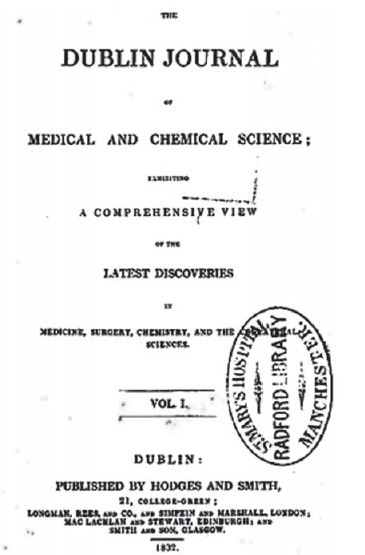
- Title page of Volume I
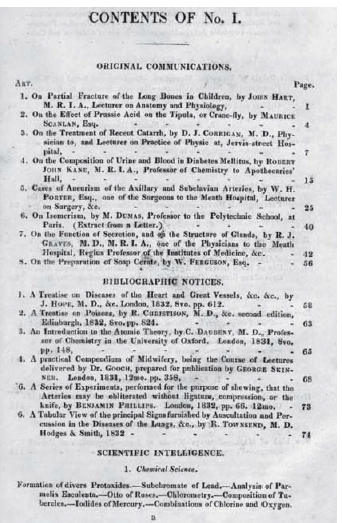
- Contents page Volume I
Dr Kane continued as editor from 1832 to 1835. In 1836, Dr Robert James Graves took over. Drs William Stokes and William Henry Porter were co-editors. The trio continued to edit this journal from 1836 to 1842.
Graves, famed for his work on diseases of the thyroid gland, had contributed a regular column from 1824 onwards to the Edinburgh Medical and Surgical Journal highlighting in English the latest in German medical research. The Dublin journal soon became the flagship periodical of the Dublin school.6
Sections in each volume of this journal
The contents were attanged under sections:
Original contributions
Bibliographic notices
Scientific Intelligence—the entries here were often excerpts from a variety of European journals.
Chemical Science
Physical Science
Botany and Natural History
Anatomy and Physiology
Pathology and Therapeutics
Surgery
Legal Medicine and Toxicology
Materia Medica and Pharmacy
The first paper in volume 1, number 1, by John Hart, Surgeon to the Dublin General Dispensary dealt with fractures of long bones in children and provided a graphic description of what we now term greenstick fractures (Fig. 4). ‘…This injury is a fracture which extends through a part of the diameter of the bone, the remaining part becoming bent in the manner in which a branch of a tree yields to an attempt to break it while it still retains a sap… this kind of fracture is not particularly described in any of our systematic works on Surgery…’
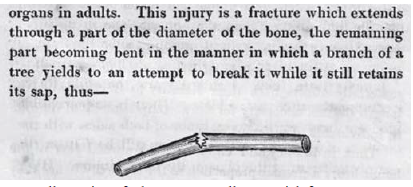
- Illustration of what we now call greenstick fracture
The third paper is by Dr D.J. Corrigan and deals with the treatment of recent catarrh. The same year he published his description of the ‘collapsing pulse’ in the paper entitled ‘On permanent patency of the mouth of the aorta, or inadequacy of the aortic valves’ but this was in The Edinburgh Medical and Surgical Journal (1832;37:225–45). This is not surprising for he had obtained his MD in Edinburgh in August 1825. He was created a baronet in 1866. It is of interest that in 1846, when he applied to become a fellow of the Royal College of Physicians of Ireland he was rejected. He got his fellowship in 1856, and went on to become President of this College, the first Catholic to be so elected. He was re-elected president an unprecedented four times.
Dr Robert Graves’ paper ‘On the function of secretion and on the structure of glands’ is published on pages 42–55. He was already Regius Professor of the Institutes of Medicine. (In the 1830s this term was used to describe the inter-relations between anatomy, physiology and pathology and the principles of therapy.) His descriptions are fascinating. ‘…In its most general sense, secretion means the power possessed by any organ, or any part of the system, of forming from the blood peculiar animal fluids, whose chemical properties differ essentially from those of the blood itself. I have said fluids because it is now generally believed that solids are never directly formed by secretion…’ In his paper he refers to the work of Andral, Magendie (spelt Majendie), Bichat, Malphigi, Ruysch, Muller, Haller, Cuvier and others. ‘Malphigi believed the brain to be glandular and he thought that the cortical substance of the kidneys consists of a mass of minute glands traversed by innumerable serpentine vessels…’ His paper on the disease named after him was published 3 years later and in a different journal. (Newly observed affection of the thyroid. Clinical Lectures, London Med. & Surg. J. 1835;7:516–17).
The second issue contained Dr William Stokes’ paper on effects of opium in large doses in patients with peritonitis. The advocacy of such usage would be frowned upon today but we must remind ourselves that this account was written in 1832. In a report published earlier by Dr Stokes and Dr Graves, they had noted that in such patients, ‘it is almost romantic to expect that any treatment can save life. Here is a violent, sudden and universal peritonitis brought on, less by the extension of diseased action from one tissue to another, than by the introduction into the sac of a highly irritating fluid… The disease runs its course in a very short space of time and though the physician be called early, he is late quod the disease, or at least the period of it when the usual mode of treatment can be available.’ Bleeding (as therapy) would only worsen the patient’s condition. Mercury could not be given orally. Whilst hopelessness might be justified, ‘how rarely do we see a case of disease in which nature does not make some attempt towards a cure.’ Their efforts to help nature took the form of giving opium in large doses. In 1823, Dr Graves had successfully treated two patients with peritonitis thus. In this paper, Dr Stokes described a recent patient where he had met with similar success. The clinical descriptions are typical of that age—detailed and complete. In all, one hundred and five grains of opium were given, excluding that by injection. A study of this paper is strongly recommended before any criticism on the treatment is voiced. Stokes and Graves had noted the formation of adhesions and sealing of the rupture in the bowel by nature in some of their patients. In 1832 there were no antibiotics. No radiological tests were possible, Surgery was fraught with grave dangers. Dr William Morton’s demonstration of the efficacy of anaesthesia was made on 16 October 1846.
Subsequent issues carry more papers that stimulate our curiosity. Dr Robert Graves wrote ‘On double and single vision’, Dr Robert Kane ‘On the iodide of platinum and its saline combinations’ and so on.
Bibliographic notices included detailed reviews of recently published books such as: Treatise on poisons in relation to medical jurisprudence, physiology and the practice of physic by Robert Christison, Professor of Medical Jurisprudence, University of Edinburgh; An introduction to the atomic theory, comprising a sketch of the options entertained by the most distinguished ancient and modern philosophers with respect to the constitution of matter by Charles Daubeny, Professor of Chemistry, University of Oxford; A series of experiments, performed for the purpose of that arteries may be obliterated with ligature, compression or the knife by Benjamin Philips.
Under Chemical science is featured Chemical composition of tubercles (of the lung and liver). These were studied for their content of animal matter, phosphate of lime, carbonate of lime and salts soluble in water. Analysis of oil of roses pointed out that ‘…when dissolved in spirit of wine…a single drop was sufficient to fill a room with a most agreeable odour of roses.’ Composition of the blood in jaundice included a description of the ‘salty disagreeable taste’ of the residue after evaporation of separation of albumin and evaporation of the alcohol used as a solvent.
Under Scientific intelligence we find items such as fossil forest discovered at Rome and gelatinous principle of fruits.
The section entitled Physical science included electric origin of terrestrial magnetism, conduction of sound by water, on the progressive expansion and maximum density of water and double images of objects seen through the air.
The section entitled Botany and natural history included a discussion on respiration of plants.
The section entitled Anatomy and phyiology included connexion of muscular action with vision, adaptive powers of the eye and structure of the placenta.
The section entitled Pathology and therapeutics included conversion of hydatids into tubercles, absorption of the placenta, solar medication in dropsy, intermittent cyanosis, therapeutic power of vaccine and susceptibility of different races to cholera.
The section entitled Surgery included curious case of gangrene of the penis, foreign substances in the human body, tumour expanding the spinal cord and nerves without impairing the sensation or motion of the lower extremities and ossification of the umblical cord. Irresistible curiosity on some of these items led to exploration, which provided the following information. The ligature on the penis of a 4-week-old Jewish boy was tied by the nurse employed to suckle him. ‘A long hair of the head was wound four times around the root of the penis, precisely in the same furrow and each time tied firmly with a knot… Very probably the nurse wished in this manner to revenge herself for her dismissal.’ The ‘tumour expanding the spinal chord (sic)’ was at the second dorsal vertebra in a newly born infant. Today we would term it a meningomyelocoele. A detailed autopsy report is provided which makes for fascinating reading. Obstetricians and pathologists will have much to say on the description of ossification of the umbilical cord.
The section entitled Materia medica and pharmacy includes varieties, cultivation and collection of cinchona.
THE DUBLIN JOURNAL OF MEDICAL SCIENCE (1836–45)2
The name of the journal Dublin Journal of Medical and Chemical Science was changed in 1836 (Fig. 5). Drs R.J. Graves, W. Stokes and W.H. Porter were the editors. John Hamilton and Robert Lee MacDonnell were co-editors. Dr William Wilde took over the editorial reins in 1845. Dr Wilde, a pupil of Abraham Colles, William Stokes and Robert Graves revolutionised surgery of the ear in Ireland. (He was also the father of Oscar Wilde.) He continued the tradition started in 1683 with the formation of the Dublin Philosophical Society, the Physico-Historical Society (1744) and the Medico-Philosophical Society (1756). He ensured publication of the highlights of the proceedings of the successors of these learned bodies.2
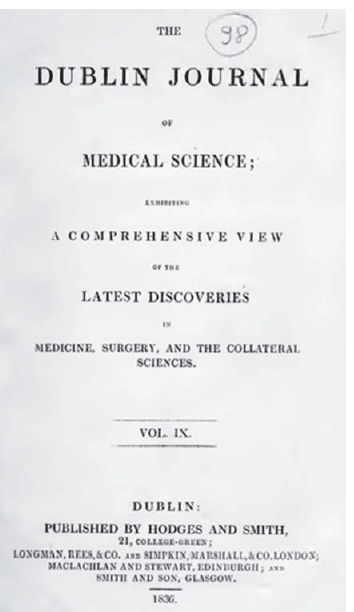
- Title page of the Dublin Journal of Medical Science
Dr William Stokes’ paper entitled ‘Researches on Laennec’s vesicular emphysema, with observations on paralysis of the intercostal muscles and diaphragm, considered as a new source of diagnosis’ is especially interesting when viewed in the context of his description of Dr Abraham Colles’ autopsy (see below).
Account of a case in which death ensued in consequence of nitric acid having been poured into the ear… by Dr J. Morrison (pages 99–105) includes accounts of the woman into whose ear the acid was poured by her husband and that of the husband, himself, who then attempted suicide by slashing his throat. Both died and were subjected to autopsy.
THE DUBLIN QUARTERLY JOURNAL OF MEDICAL SCIENCE (1846–71)
In February 1846, Dr Wilde was appointed editor of the journal under the new name of The Dublin Quarterly Journal of Medical Science (Fig. 6). Dr William Stokes and other leading physicians in Dublin continued to contribute to it.
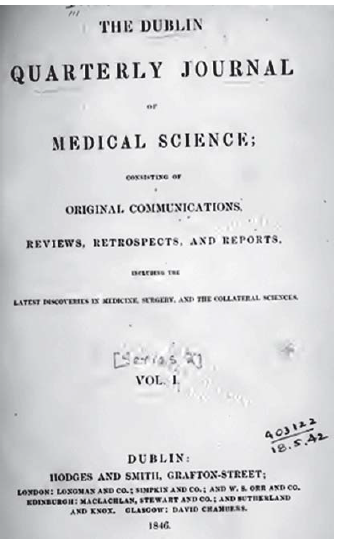
- Title page of the Dublin Quarterly Journal of Medical Science
An extraordinary paper was published in this journal in its first volume.7 In October 1842, Dr Colles had written the following letter to Dr Robert Harrison: ‘My dear Robert, I think it may be of some benefit not only to my own family, but to society at large, to ascertain by examination the exact seat and nature of my last disease. I am sure you will grant my request, that you will see that this be carefully and early done. The parts to which I would direct particular attention are the heart and the lungs, a small hernia immediately about the umbilicus and the swelling in the right hypochondrium. From the similarity of Rev. P Roe’s case with mine, I suspect that there is some connection between this swelling of the hypochondrium and the diseased state of the heart. Yours truly, dear Robert, A. Colles.’
The autopsy was performed on 9 December 1843. There was generalised oedema with a tinge of jaundice. Half a pint of dark-coloured serum was found in the right pleural cavity. The right lung was extremely congested and showed ‘two large globular tumours… obviously of an emphysematous character’. They contained not only air but also venous blood. With the exception of a small portion at the apex, the right lung was more or less vesicular, but did not present any of the characters which distinguish pneumonic solidification. The left pleural cavity was almost completely obliterated. The small lung did not crepitate and resembled the spleen. The posterior mediastinal glands contained calcareous matter. The heart was much larger than normal, showing great passive dilatation. The competence of the aortic valve was tested by pouring water into the aorta. It did not enter the left ventricle. The peritoneal sac contained a quart of fluid. The liver presented a tumid and swollen appearance. Its surface was rough and granular. The gall bladder contained thirty stones. Acute on chronic disease of the left lung, the right lung carrying out its functions and the weakened, dilated heart were felt to be the important findings. It is salutary to note that this paper on Dr Colles covers pages 303–22 (Fig. 7).

- Title of Dr Stokes’ paper on Dr Colles’ autopsy7
Later editors were as follows:
1849–61 John Moore Neligan
1861–68 George Hugh Kidd
1868–74 James Little
It was during Dr Little’s tenure that the journal changed to a monthly publication.
THE DUBLIN JOURNAL OF MEDICAL SCIENCE (1872–1925)
In 1872 this journal again became a monthly publication with James Little and John William Moore as editors. In December 1896, the Royal Academy of Medicine in Ireland appointed a Committee to consider whether it would be possible to come to some arrangement whereby this journal should be the official organ of the Academy. After several meetings it was not found to be possible to come to an agreement, and for the time the matter was dropped. In 1919, owing to the difficulties which resulted from the War and the troubles which followed it in this country, the efforts were successful and the journal was purchased by the Academy.
Students of medical history may wish to study two papers by Dr Kirkpatrick: (i) An index to the biographical notices that have appeared in the journal since its commencement in March 18328; and (ii) An index to the papers on the history of medicine that have been published in the Dublin Journal of Medical Science from its commencement to August 1916.9
THE IRISH JOURNAL OF MEDICAL SCIENCE10,11
Since March 1922, the title has been Irish Journal of Medical Science and it is, even today, the official organ of the Royal Academy of Medicine in Ireland (Fig. 8).

- Title page (a) and the inside page (b) of the The Irish Journal of Medical Science
‘During its long life from 1872 to 1926 its references were chiefly by volume and numbered issues and though not regularly indicated it included the 3rd series, the 4th series, comprising eleven annual volumes and a 5th series of four volumes from 1922–1923 to 1925. The 6th series dates from 1926. No reason for changing from one series to another was evident and it was not due to change of editorship. In March 1922 it was renamed The Irish Journal of Medical Science. At present this official organ of the Royal Academy of Medicine in Ireland is a quarterly publication and covers all branches of medicine.’ (Note on the website of the journal www.rami.ie/irish-journal-medical-science/history/)
CONCLUSION
My study has been rewarding. I unearthed hitherto hidden treasures. I have provided a few examples.
Students of the history of medicine would do well to spend time referring to papers published in the early volumes of these pioneering publications. Legendary narratives will be encountered and the reader will marvel at the clinical skills, perspicacity and innovative genius of these pathfinders. Among other pioneers, you will commune with Drs Abraham Colles, Dominic Corrigan, William Stokes, Sir William Wilde and Robert Graves.
As in most journals of those times, papers were descriptive and autopsies were essential to the understanding of disease and the efficacy of therapy. They offer rich pickings for those of us wishing to learn the origins of clinical practices and the development of understanding of disease processes.
Dr Macdonald Critchley,12 discussing Sir William Gowers’ A manual of diseases of the nervous system, had stated, ‘… anyone who thinks he has stumbled upon something new or obscure should not neglect to search the Manual before claiming originality’. The same statement can be made about these venerable tomes.
ACKNOWLEDGEMENT
I am grateful to Dr Sanjay Pai for calling my attention to Fleetwood’s The History of Medicine in Ireland.3 In addition to the text I have referred to above, it contains useful information on the development of medicine in Ireland and provides pen portraits of some of its memorable physicians and surgeons.
References
- An account of the Irish medical periodicals No. III. The Transactions of the Association of the Fellows and Licentiates of the King and Queen's College of Physicians. Dublin Journal of Medical Science. 1915;139:428-43.
- [CrossRef] [Google Scholar]
- An account of the Irish medical periodicals No. IV. The Dublin Journal of Medical Science. The Dublin Journal of Medical Science. 1915;140:1-13.
- [CrossRef] [Google Scholar]
- A contribution to medical history: Thomas Dover M. B of Dover's Powder, physician and buccaneer. The Lancet. 1896;147:4-7.
- [CrossRef] [Google Scholar]
- Medicine. disease and the state of Ireland 1650-1940. Cork, Ireland: Cork University Press;
- [Google Scholar]
- The Dublin Journal of Medical and Chemical Science 2010. UCD Irish Virtual Research Library and Archive Available at http://hdl.handle.net/10197/2487 (accessed on 20 Feb 2024)
- [Google Scholar]
- Observations on the case of the late Abraham Colles M.D formerly Professor of Surgery in the Royal College of surgeons of Ireland. The Dublin Quarterly Journal of Medical Science. 1846;1:303-22.
- [CrossRef] [Google Scholar]
- Percy: An index to the biographical notices that have appeared in the journal since its commencement in March 1832. Dublin Journal of Medical Science. 1916;141:110-18.
- [CrossRef] [Google Scholar]
- Percy: An index to the papers on the history of medicine that have been published in the Dublin Journal of Medical Science from its commencement to August 1916. Dublin Journal of Medical Science. 1916;141:302-10.
- [CrossRef] [Google Scholar]
- History of the Irish Journal of Medical Science. Available at www.rami.ie/irish-journal-medical-science/history/ (accessed on 20 Feb 2024)
- [Google Scholar]
- Organisation of the Irish medical profession. Irish Journal of Medical Science. 1922;2:5-17.
- [CrossRef] [Google Scholar]
- Sir William Gowers 1845-1915 A biographical appreciation. London: William Heinemann Books; 1949.
- [Google Scholar]




